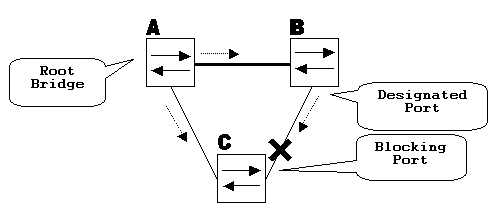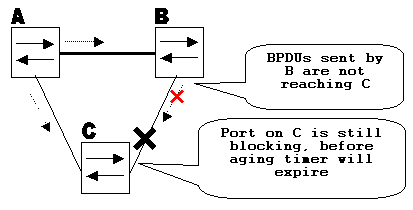Introduction
This document describes how the Unidirectional Link Detection (UDLD) protocol can help to prevent loops and traffic anomalies in switched networks.
Prerequisites
Requirements
There are no specific requirements for this document.
Components Used
This document is not restricted to specific software and hardware versions.
The information in this document was created from the devices in a specific lab environment. All of the devices used in this document started with a cleared (default) configuration. If your network is live, ensure that you understand the potential impact of any command.
Conventions
Refer to Cisco Technical Tips Conventions for more information on document conventions.
Problem Definition
Spanning-Tree Protocol (STP) resolves redundant physical topology into a loop-free, tree-like forward topology.
To do this, it blocks one or more ports. With one or more ports blocked, there are no loops in the forward topology. STP relies in its operation on reception and transmission of the Bridge Protocol Data Units (BPDUs). If the STP process that runs on the switch with a port in blocking state do not receive BPDUs from its upstream (designated) switch, STP eventually ages out the STP information for the port and moves it to the forwarding state.
This can create a STP loop where packets start to cycle indefinitely along the looped path, and consumes more and more bandwidth and resources. This leads to a possible network outage.
How is it possible for the switch to not receive BPDUs while the port is up ? The reason is a unidirectional link.
A link is considered unidirectional when this occurs:
Consider this scenario. The arrows indicate the flow of STP BPDUs.

During normal operation, bridge B is a designated port on the link B-C. Bridge B sends BPDUs down to C, which is the blocking the port. The port is blocked while C sees BPDUs from B on that link.
Now, consider what happens if the link B-C fails in the direction of C. C ceases to receive traffic from B, however, B still receives traffic from C.
up
C does not receive BPDUs on the link B-C, and ages the information received with the last BPDU. This takes up to 20 seconds, which depends on the maxAge STP timer. Once the STP information is aged out on the port, that port transitions from the blocking state to the listening , learning , and eventually to the forwarding STP state. This creates a loop, as there is no blocked port in the triangle A-B-C. Packets cycle along the path (B still receives packets from C) which consumes additional bandwidth until the links are completely filled up.
This scenario can bring the network down. Another possible issue that can be caused by a unidirectional link is a traffic blackhole.

How Unidirectional Link Detection Protocol Works
UDLD is a Layer 2 (L2) protocol that works with the Layer 1 (L1) mechanisms to determine the physical status of a link. At Layer 1, auto-negotiation takes care of physical signaling and fault detection. UDLD performs tasks that auto-negotiation cannot perform, such as the detection of the identities of neighbors and shut down misconnected ports. When you enable both auto-negotiation and UDLD, Layer 1 and Layer 2 detections work together to prevent physical and logical unidirectional connections and the malfunctioning of other protocols.
UDLD works through the exchange of protocol packets between the neighboring devices. In order for UDLD to work, both devices on the link must support UDLD and have it enabled on the respective ports.
Each switch port configured for UDLD sends UDLD protocol packets that contain the port device/port ID, and the neighbor device/port IDs seen by UDLD on that port. Neighboring ports see their own device/port ID (echo) in the packets received from the other side. If the port does not see its own device/port ID in the incoming UDLD packets for a specific duration of time, the link is considered unidirectional.
This echo-algorithm allows detection of these issues:
-
Link is up on both sides, however, packets are only received by one side.
-
Connection (wire) mistakes when receive and transmit fibers are not connected to the same port on the remote side.
Once the unidirectional link is detected by UDLD, the respective port is disabled and this message is printed on the console:
UDLD-3-DISABLE: Unidirectional link detected on port 1/2. Port disabled
Port shutdown by UDLD remains disabled until it is manually enabled, or untilerrdisabletimeout expires (if configured).
UDLD Modes of Operation
UDLD can operate in two modes: normal and aggressive: .
- In normal mode, if the link state of the port was determined to be bi-directional and the UDLD information times out, no action is taken by UDLD. The port state for UDLD is marked as undetermined . The port behaves in accordance with its STP state.
- In aggressive mode, if the link state of the port is determined to be bi-directional and the UDLD information times out while the link on the port is still up , UDLD tries to re-establish the state of the port. If not successful, the port is put into the errdisable state.
Age out of UDLD information happens when the port that runs UDLD does not receive UDLD packets from the neighbor port for the duration of hold time. The hold time for the port is dictated by the remote port and depends on the message interval at the remote side. The shorter the message interval, the shorter the hold time and faster the detection. Recent implementations of UDLD allow configuration of message interval. UDLD information can age out due to the high error rate on the port caused by some physical issue or duplex mismatch. Such packet drop does not mean that the link is unidirectional and UDLD in normal mode does not disable such link.
It is important to be able to choose the right message interval in order to ensure proper detection time. The message interval needs to be fast enough to detect the unidirectional link before the forward loop is created, however, it must not overload the switch CPU. The default message interval is 15 seconds, and is fast enough to detect the unidirectional link before the forward loop is created with default STP timers. The detection time is approximately equal to three times the message interval.
For example: Tdetection~ message_interval x3
This is 45 seconds for the default message interval of 15 seconds.
It takes Treconvergence=max_age + 2x forward_delay for the STP to reconverge in case of unidirectional link failure. With the default timers, it takes 20+2x15=50 seconds.
It is recommended to keep Tdetection< Treconvergence and choose an appropriate message interval.
In aggressive mode, once the information is aged, UDLD makes an attempt to re-establish the link state and send packets every second for eight seconds. If the link state is still not determined, the link is disabled.
Aggressivemode adds additional detection of these situations:
-
The port is stuck (on one side the port neither transmits nor receives, however, the link is up on both sides).
-
The link is up on one side and down on the other side. This issue can seen on fiber ports when transmit fiber is unplugged on the local port, the link remains up on the local side. However, it is down< /tt>on the remote side.
Most recently, fiber FastEthernet hardware implementations have Far End Fault Indication (FEFI) functions in order to bring the link down on both sides in these situations. On GigabitEthernet, a similar function is provided by link negotiation. Copper ports are normally not susceptible to this type of issue, as they use Ethernet link pulses to monitor the link. It is important to mention that in both cases, no forward loop occurs because there is no connectivity between the ports. However, if the link is up on one side and down on the other traffic blackhole can occur. Aggressive UDLD is designed to prevent this.
Availability
UDLD is available in normal and aggressive mode from Cisco IOS® Software Release 12 and later.
Configuration and Monitoring
Run the command show udld to verify if UDLD is enabled on the interfaces:
Switch#show udld
Interface Gi1/0/1
---
Port enable administrative configuration setting: Disabled
Port enable operational state: Disabled
Current bidirectional state: Unknown
Interface Gi1/0/2
---
Port enable administrative configuration setting: Disabled
Port enable operational state: Disabled
Current bidirectional state: Unknown
Interface Gi1/0/3
---
Port enable administrative configuration setting: Disabled
Port enable operational state: Disabled
Current bidirectional state: Unknown
Aggressive UDLD can be configured on the interface with the udld port aggressive command:
Switch#configure terminal
Enter configuration commands, one per line. End with CNTL/Z.
Switch(config)#interface gigabitEthernet1/0/1
Switch(config-if)#udld port aggressive
Switch(config-if)#end
Switch#
Issue theshow udld <interface> and show udld neighbors command to verify whether UDLD is enabled or disabled on the port and what the link and neighbor state is:
Switch#show udld GigabitEthernet1/0/1
Interface Gi1/0/1
---
Port enable administrative configuration setting: Enabled / in aggressive mode
Port enable operational state: Enabled / in aggressive mode
Current bidirectional state: Bidirectional
Current operational state: Advertisement - Single neighbor detected
Message interval: 15000 ms
Time out interval: 5000 ms
Port fast-hello configuration setting: Disabled
Port fast-hello interval: 0 ms
Port fast-hello operational state: Disabled
Neighbor fast-hello configuration setting: Disabled
Neighbor fast-hello interval: Unknown
Entry 1
---
Expiration time: 31600 ms
Cache Device index: 1
Current neighbor state: Bidirectional
Device ID: 346288238580
Port ID: Gi4/0/1
Neighbor echo 1 device: 70B4F35F080
Neighbor echo 1 port: Gi1/0/1
TLV Message interval: 15 sec
No TLV fast-hello interval
TLV Time out interval: 5
TLV CDP Device name: MXC.TAC.M.02-3850-01
Switch#show udld neighbors
Port Device Name Device ID Port ID Neighbor State
---- ----------- --------- ------- --------------
Gi1/0/1 346288238580 1 Gi4/0/1 Bidirectional
Total number of bidirectional entries displayed: 1
Use the udld message time command to change the message interval:
Switch(config)#udld message time 10
UDLD message interval set to 10 seconds
The interval can range from 1 to 90 seconds, with the default of 15 seconds.
Related Information


 Feedback
Feedback